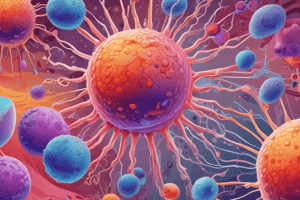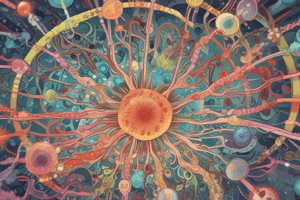Podcast
Questions and Answers
What is the approximate percentage of fluid that the lymphatic system returns to the blood vascular system?
What is the approximate percentage of fluid that the lymphatic system returns to the blood vascular system?
- 5%
- 15% (correct)
- 35%
- 25%
If the lymphatic system is compromised, leading to fluid accumulation in the distal extremities, what condition is most likely to develop?
If the lymphatic system is compromised, leading to fluid accumulation in the distal extremities, what condition is most likely to develop?
- Edema (correct)
- Fibrosis
- Atrophy
- Ischemia
Which of the following is the primary function of the lymphatic system related to interstitial fluid?
Which of the following is the primary function of the lymphatic system related to interstitial fluid?
- Introducing more waste products into tissues
- Removing approximately 15% of the interstitial fluid (correct)
- Increasing hydrostatic pressure in tissues
- Increasing blood osmolarity
In which of the following locations would superficial lymphatic vessels NOT be found?
In which of the following locations would superficial lymphatic vessels NOT be found?
What is the primary role of dendritic cells within the afferent lymphatic vessels of a lymph node?
What is the primary role of dendritic cells within the afferent lymphatic vessels of a lymph node?
Which of the following is a characteristic of secondary lymphoid follicles that distinguishes them from primary follicles?
Which of the following is a characteristic of secondary lymphoid follicles that distinguishes them from primary follicles?
If a toxin disrupted the normal function of T cells within the thymus, which of the following processes would be most directly affected?
If a toxin disrupted the normal function of T cells within the thymus, which of the following processes would be most directly affected?
After lymph passes through the intermediate sinus of a lymph node, to which region does it flow next?
After lymph passes through the intermediate sinus of a lymph node, to which region does it flow next?
Which characteristic is associated with the mucosa-associated lymphoid tissue (MALT)?
Which characteristic is associated with the mucosa-associated lymphoid tissue (MALT)?
How does the spleen contribute to immunological responses?
How does the spleen contribute to immunological responses?
Which of the following attributes relates to deep lymphatic vessels?
Which of the following attributes relates to deep lymphatic vessels?
A patient has a localized infection in their right lower limb. Which group of lymph nodes would most likely be the first to respond to this infection?
A patient has a localized infection in their right lower limb. Which group of lymph nodes would most likely be the first to respond to this infection?
What is the consequence in a patient if mutations in tumour suppressor related pathways occur?
What is the consequence in a patient if mutations in tumour suppressor related pathways occur?
How do the walls of lymphatic vessels compare to those of great veins?
How do the walls of lymphatic vessels compare to those of great veins?
What are the products of carbohydrate and amino acid digestion transported through into the blood capillary network?
What are the products of carbohydrate and amino acid digestion transported through into the blood capillary network?
What region is the pharyngeal tonsil located?
What region is the pharyngeal tonsil located?
What is the origin of T-cells?
What is the origin of T-cells?
From where does the right lymphatic duct receive lymph?
From where does the right lymphatic duct receive lymph?
What type of cells are natural killer cells?
What type of cells are natural killer cells?
How can the tonsils be described?
How can the tonsils be described?
What do the largest chain fatty acids require to enter the lymphatic system?
What do the largest chain fatty acids require to enter the lymphatic system?
Which of the types of cells listed produce and dispatch anitbodies for foreign objects?
Which of the types of cells listed produce and dispatch anitbodies for foreign objects?
What is the function of the spleen?
What is the function of the spleen?
Which lymphatic trunk is unpaired?
Which lymphatic trunk is unpaired?
What description relates to the condition Multiple Sclerosis?
What description relates to the condition Multiple Sclerosis?
Flashcards
Lymphatic System Function 1
Lymphatic System Function 1
Returns leaked fluid from the blood vascular system back to the blood.
Lymphatic System Function 2
Lymphatic System Function 2
Protects the body by removing foreign materials.
Lymphatic System Function 3
Lymphatic System Function 3
Transports large molecules that cannot diffuse through capillary walls to enter the blood.
Interstitial Fluid (IF)
Interstitial Fluid (IF)
Signup and view all the flashcards
Lymphatic Capillary
Lymphatic Capillary
Signup and view all the flashcards
Lymphatic Vessels
Lymphatic Vessels
Signup and view all the flashcards
Lymphatic Trunks
Lymphatic Trunks
Signup and view all the flashcards
Lymph Ducts
Lymph Ducts
Signup and view all the flashcards
Lymph Nodes
Lymph Nodes
Signup and view all the flashcards
Primary Lymphoid Organs
Primary Lymphoid Organs
Signup and view all the flashcards
Secondary Lymphoid Organs
Secondary Lymphoid Organs
Signup and view all the flashcards
MALT
MALT
Signup and view all the flashcards
Lymphatic system
Lymphatic system
Signup and view all the flashcards
Superficial Lymphatic Vessels
Superficial Lymphatic Vessels
Signup and view all the flashcards
Thoracic Duct
Thoracic Duct
Signup and view all the flashcards
Venous angle
Venous angle
Signup and view all the flashcards
Red bone marrow
Red bone marrow
Signup and view all the flashcards
Thymus gland
Thymus gland
Signup and view all the flashcards
Lymphnode function
Lymphnode function
Signup and view all the flashcards
Spleen
Spleen
Signup and view all the flashcards
Lymph
Lymph
Signup and view all the flashcards
Study Notes
- Lymphocytes elicit an immune response to foreign material
- Lymphocytes are a type of white blood cell
- Lymphocytes develop from lymphoblasts within lymphoid tissue, for eg. thymus
Types of Lymphocytes:
- Natural killer cells (NK)
- B lymphocytes
- T lymphocytes
Abnormal Lymphocyte Levels
- Some mutations in tumour suppression pathways can cause uncontrolled growth of B and T lymphocytes
- HIV decreases the number and function of T lymphocytes, cannot fight infection
- T cells initiate damage to the nervous system in multiple sclerosis
Lymphoid Cells
- Formed and matured in bone marrow
- Respond to pathogens by producing and dispatching antigen-specific antibodies, that neutralize foreign objects
- Found in the Lymph Node cortex dividing B cells, in germinal centers
CD8 T CELL
- Targets pathogens associated with an antigen
T Cells
- Some T-Cells are formed in the bone marrow, and mature in the thymus
- Some T-Cells are involved in cell-to-cell (cell mediated) immunity
- T-Cells are located in the deep cortex
- Two types are Helper T cells (CD4) and Cytotoxic T cells (CD8)
Primary Lymphoid Organs
- Includes red bone marrow, where haemopoiesis which produces all formed elements of the blood
- Bone marrow is diffusely located in central portions of flat bones and epiphyses of long bones
- B lymphocyte production and maturation occurs within the bone marrow
Thymus
- Composed of two identical lobes, located in the superior and anterior mediastinum
- It enlarges during childhood, atrophies at puberty, and is generally replaced with fat
- Main components are the cortex and medulla
- T-cells are generated in the bone marrow and travel to the thymus to mature
- Lymphoid stem cells in the cortex divide, mature into T cells and migrate into the medulla
- T cells that attack self-antigens are destroyed by the thymus during selection processes in lymphocyte proliferation and maturation
Secondary Lymphoid Organs
- Lymph nodes filter lymph
- They trap foreign material such as bacterial and viral particles
- The largest Lymphoid organ is the Spleen: Located in the left upper quadrant, between the 9th and 11th ribs
- The spleen removes abnormal blood cells and other blood components through phagocytosis
- Initiates an immune response by B and T cells following the stimulation of circulating antigens in the blood
- Note that spleens filter blood, whilst lymph nodes filter lymph
Lymphatic System
- Weekly learning objective is to describe the structure and function of the lymphatic system summarize the clinically relevant location of node groups
- The student should demonstrate an understanding of the key functions of the lymphatic system
- The student should demonstrate an understanding of the structure, development, and location of lymphoid tissue (primary vs secondary organs)
- Lymphatic transport and distribution is also important to be able to discuss
- The clinical implications of differing lymphoid system disorders should be considered
Lymphatic System Function
- Returns fluids that have leaked from the blood vascular system back to blood (15% of the bodies fluid)
- It protects the body by removing foreign materials like pathogens
- Transports large molecules that cannot diffuse through the capillary wall to enter blood
Interstitial Space and Fluid (IF)
- Approximately 85% of the fluid lost at the arterial end of the capillary bed is reclaimed into the blood at the venous end
- Waste products like O2, water, CO2, and nitrogenous waste are components
- Other components include electrolytes, amino acids, hormones, and lipids
Fluid Movement
- Approximately 20L seeps out, 17L reabsorbed, 3L left in tissues
- Interstitial fluid (IF) enters lymphatic capillary
- Lymph then flows to larger lymphatic vessels, both superficial and deep
- Lymphatic vessels then lead to lymphatic trunks
- Trunks then unite and either form the right lymphatic trunk and the thoracic duct
Lymphatic Vessels
- Two sets of vessels drain lymph from the capillaries including a superficial and deep lymphatic vessel
- Superficial vessels travel with superficial veins, are located in the subcutaneous layer next to the skin
- Superficial vessels are located in the loose connective tissue of the mucous membrane lining the digestive, respiratory, urinary and reproductive tracts
- They also occur in the loose connective tissues of the serous membranes lining the pleural, pericardial and peritoneal cavities
- Deep vessels accompany large arteries and veins; and they drain the skeletal muscle as well as organs in the neck, limbs and trunk
- They also drain visceral organs in the thoracic and abdominopelvic cavities.
Lymph Nodes
- Lymph enters the node via afferent vessels
- Dendritic cells present pathogens to T-helper cells
- Lymph moves through the subscapular sinus and into smaller sinuses
- Lymph moves through the intermediate sinus to the medullary sinus
- Lymph exits the node at its hilum via efferent vessels
Lymphatic Vessels
- There as two sets of vessels that drain lymph from the capillaries including a superficial and deep lymphatic vessel
- Superficial vessels travel with superficial veins and are located in the subcutaneous layer next to the skin
- Superficial vessels are located in the loose connective tissue of the mucous membrane lining the digestive, respiratory, urinary and reproductive tracts
- Deep vessels accompany large arteries and veins; and drain the skeletal muscle as well as organs in the neck, limbs and trunk
- These vessels drain visceral organs in the thoracic and abdominopelvic cavities
Lymphatic Trunks
- Lumbar trunks drain the legs, pelvic region, and kidneys.
- The intestinal trunk receives chyle (lymph mixed with fats) from the intestines.
- Bronchomediastinal trunks are located in the chest, they drain lymph from the lungs, heart, trachea, mediastinal, and mammary glands.
- Subclavian trunks are located beneath the clavicle, as they drain lymph fluid from the apical lymph nodes around the armpit, which carry lymph from the arms
- Jugular trunks are located in the neck; they drain lymph fluid from the cervical lymph nodes of the neck.
Lymph Ducts
- Receive lymph from the lymph trunks, and are the largest lymph vessels
- Vessels contain three layers, similar to those of great veins
- The thoracic duct receives from both sides of the body inferior to the diaphragm and left side of head and neck, thorax, and upper limb
- The right lymphatic duct drains the right upper quadrant above the diaphragm (head/neck, thorax, arm)
- Both ducts drain lymph from the venous angle between the internal jugular and subclavian veins, and enter the heart via the superior vena cava
Mucosa Associated Lymphoid Tissue (MALT)
- MALT are strategically located in mucous membranes and are the most extensive component of human lymphoid tissue
- First line of protection as they can be classified as lymphoid nodules, and do not have a capsule with a germinal center with activated lymphocytes
- MALT includes tonsils, Peyer’s patches and the appendix
Tonsils:
- Form a ring of respiratory defence around the entrance of the pharynx (throat) and appear as swellings in the mucosa
- The pharyngeal tonsil is located in the posterior wall of the nasopharynx, where, when enlarged they are known as adenoids
- Palatine tonsils (paired) are found on either side at the posterior end of the oral cavity (most often infected)
- Tubal tonsils surround the opening of the auditory tubes in the pharynx
- Lingual tonsils are found at the base of the tongue
Studying That Suits You
Use AI to generate personalized quizzes and flashcards to suit your learning preferences.



